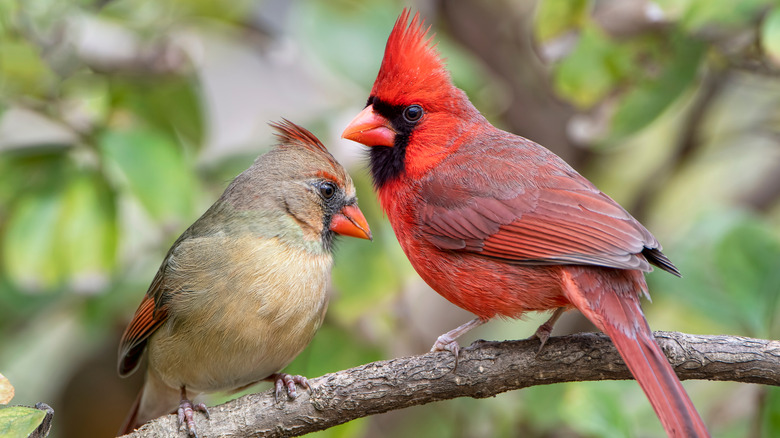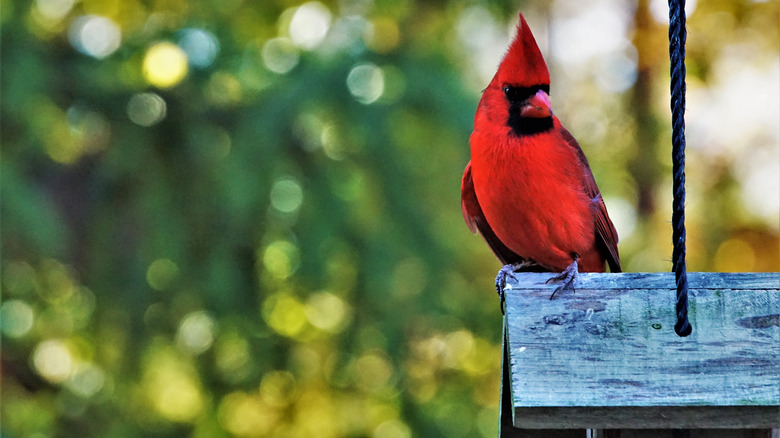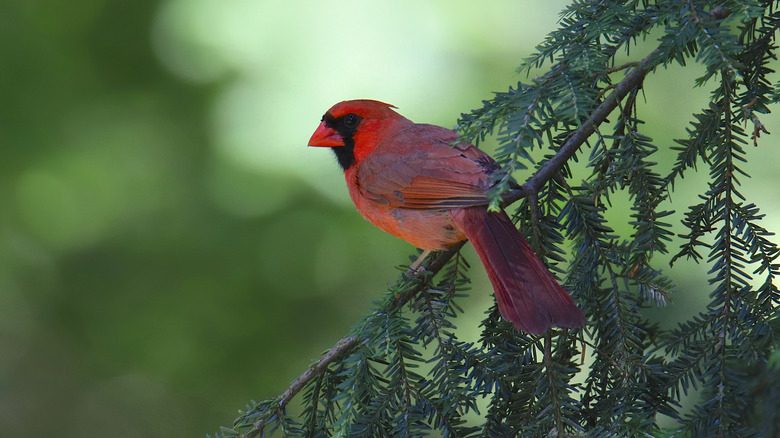How To Attract Cardinals To Your Garden
Cardinals are beautiful birds that adorn many backyards and wild landscapes across the U.S. The males can be easily identified by their brilliant red feathered coat, and tufted crest atop their head, notes All About Birds. Female cardinals bear a smaller tuft and accents of the same bright red, but their feathers are primarily a much duller brown. Both male and female cardinals, however, have black feathers in the shape of a beard around their eyes and red beaks, providing sharp color contrast and making it clear that the two birds are of the same species.
Cardinals are also lively songbirds, attracting attention for their singing in addition to their vibrant coloring. They communicate via a distinct, repetitive whistling, and male and female pairs may sing in a duet to strengthen their bond. The female will also call out from the nest to direct the male in his search for food. According to Bird Fact, Cardinals are primarily found in the southeastern United States, but their range extends as far north as Maine and Michigan, and as far west as Arizona. They are non-migratory, staying within the same place once they mark out their territory. Chances are, you are seeing the same cardinals make repeated visits to your backyard. If your garden or patio is missing this bright red beauty, check out these tips to attract more gardens to your outdoor space.
Offer their favorite food sources
Cardinals whistling and flitting around add a sense of enchantment to any backyard. If you happen to live in a colder climate, they are a welcome visual delight, contrasting against the dreary weather or snow-white backdrop. You'll need, however, a few different strategies to draw them in.
Start by providing an accessible bird feeder. Tube feeders, mesh models, and platform feeders are all affordable and easy-to-install options that cardinals recognize and enjoy visiting, according to Birds and Blooms. If attracting other critters such as squirrels is a concern, you could also try one specifically designed to appeal to birds, but blocks other animals from gaining access to the food.
Speaking of food, you'll have the most success attracting cardinals by filling your feeders with their favorite treats. Cardinals particularly enjoy mixes that include sunflower seeds, safflower seeds, peanuts, and corn — staples that are no match for their tough little beaks. According to Kaytee, cardinals will also be pleased if you provide a source of running water for them to drink or bathe in after a particularly messy meal at your bird feeder. This is especially helpful in the winter months when running water is hard to come by in the wild.
Plant shrubs and trees
Territorial by nature, cardinals seek out nesting areas that provide shelter from predators and other birds. While they can be found in semi-open areas, they are generally better protected in environments with thick bushes, tall brush, or towering pines. You can better mimic their wild habitats by adding to your garden dogwood or crabapple trees, or evergreen shrubs of varying heights to create a layered effect that will persist throughout the changing seasons, suggests Better Homes & Gardens. As mentioned earlier, cardinals will remain in the same area, so if you create a habitat that appeals to them, you will likely be rewarded with repeated sightings whether the birds are just visiting or decide to make your yard their permanent home.
If you already have established landscaping you are hesitant to change, you can take less drastic steps to still provide adequate shelter for cardinals. While you may enjoy the look of a neatly tidied yard, the cardinals would prefer you leave things a bit on the messier side. According to Better Homes & Gardens, cardinals will make quick use of any sticks or fallen leaves littering your yard over the week or so it takes them to construct their nest. Less pruning also means more perches for cardinals and other bird species to use to seek out food or rest upon while they fill the air with their melodic whistling. Whichever strategy you choose, you won't regret readying your backyard to attract these beautiful birds.


